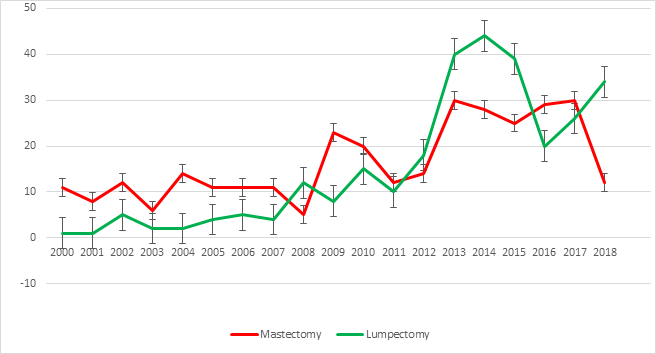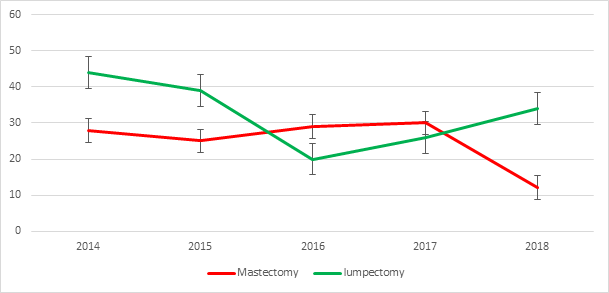
- Review Article
- |
- Open Access
Mastectomy versus breast conserving surgery: A single surgeon’s audit from a developing country
- Maha Abdel Hadi
- Department of Surgery, Imam Abdulrahman Bin Faisal University, Saudi Arabia

| Received | : | Mar 21, 2019 |
| Accepted | : | Apr 22, 2019 |
| Published Online | : | Apr 26, 2019 |
| Journal | : | Annals of Breast Cancer |
| Publisher | : | MedDocs Publishers LLC |
| Online edition | : | http://meddocsonline.org |
Cite this article: Hadi MA. Mastectomy versus breast conserving surgery: A single surgeon’s audit from a developing country. Ann Breast Cancer.1009; 2(1); 2009.
Abstract
Aim: P To review the surgical management of breast cancer based on the adoption of the available surgical options and resources in developing countries.
Materials and Methods: This review was undertaken at a university hospital with tertiary care facilities. All patients diagnosed with breast cancer between 2000-2018 were included. Demographic data and the offered surgical options were the focus of this review. The review categorized the data into two groups: mastectomy and Breast Conserving Surgery (BCS).
Results: The total number of the surgically treated breast cancer during the above period were 602 patients. Age ranged between 24-83 with the median age of 48 years. Mastectomy was performed in 312 (52%) patients while BCS in 290 (48%) patients. In the early years Mastectomy was more frequently performed than BCS, however, the last decade have shown that BCS is slowly becoming the more adopted surgical option.
Conclusion: The adoption of breast cancer surgical procedures is based on the multidisciplinary consults and the availability of treatment resources. With the emerging early detection strategies and oncoplastic procedures, more conservative approaches are propagated and encouraged in developing countries.
Keywords: Mastectomy; lumpectomy; Breast cancer
Introduction
Breast cancer was noted as early as over three thousand years ago by the ancient Egyptians. Interestingly it was then described as a systemic disease that cannot be treated by local excisions. It wasn’t until the second century AD when the first reported mastectomy was performed by a surgeon named Leonides of Alexandria. By 1600s in northern Europe more breast amputations were performed using forceps, knives, and cauterizing irons long before antisepsis and anesthesia was introduced. John Hunter, Astley Cooper, and John Warren were labelled as “Great surgeons” due to their ability to perform swift and precise procedures [1].
In 1846 the introduction of anesthesia potentiated the ease of surgical procedures propagating the name “the century of the surgeon.”Bilroth in Germany, Handley in London, and Halsted in Baltimore stood out as prominent bold cancer surgeons who designed procedures to remove the tumors and regional the lymph nodes. Halsted advocated that radical mastectomy which became the basis of breast cancer surgery for almost a century. In the 1970s, with more understanding of the systemic nature of breast cancer based on Paget’s theory less extensive procedures were then adopted [2].
Unlike the remarkable evolution of adjuvant chemo\ radiotherapy treatments, the basic principles of surgical treatments have not shown dramatic changes over the years. Cancer treatment is currently based on the multidisciplinary approach, oncoplastic surgical procedures coupled with modern adjuvant therapy.
Materials and Methods
This review was undertaken at a university hospital with tertiary care facilities. All patients diagnosed with breast cancer between 2014-2018 were included. Demographic data and surgical options were the focus of this study. The patients were categorized into two groups those who underwent mastectomyMaterials and Methods and those were BCS was the best surgical option. Comparison was also made to the first half of the decade in both presentation and surgical options.
Results
The total number of the surgically treated breast cancer during the above period were 602 patients. Age ranged between 24-83 with the median age of 48 years. Mastectomy was performed in 312 (52%) patients (Figure 1). BCS was performed in 290 (48%) patients (Figure 2).
At the beginning of the last decade Mastectomy was the adopted surgical option for all patients diagnosed with breast cancer (Figure 3).
Figure 3: Demonstrates mastectomy maintained was the adopted surgical option on the first half of the last decade as BCS slowly gained momentum.
However, in the second half of this decade BCS is slowly becoming the more adopted surgical option. This may be explained by the breast cancer programs despite its scarcity, it shows a positive impact on early detection in developing communities (Figure 4).
Figure 4: Demonstrates that mastectomy is maintaining its pace while BCS emerging as equally adopted option
When these results were compared to previous reports from the same institution results were encouraging since mastectomy was nearly the only surgical option offered reflecting the deferring women from accepting the procedures thus, explaining the roots of the delayed presentations.
Discussion
Breast cancer is the commonest malignancy among women. Generally the reliability is then focused on breast cancer awareness programs to improve outcomes.
Reports have shown that 57% of cancers occur in low- and middle-income countries with 50% - 90% of the underprivileged population are deprived from access to radiation facilities [3].
In developing countries, the scarcity of breast cancer awareness programs coupled with the young age and delayed presentation, the limited resources further compounds the problem and contribute to incomplete treatments and grave outcomes [4].
The culture of the multidisciplinary approach for breast cancer management is not fully adopted in developing countries. The understanding of the complexity of Breast cancer mandates the MDT approach which provides practice guidelines with positive impact on the decisions for management plans [5].
Breast cancer staging concisely summarizes the disease status, creating a framework for assessing and planning of treatment options and predict outcomes [6]. Prognostic clinical factors such as TNM classification that remains the standard methods of staging breast cancer. Other prognostic criteria considered are tumor grade, proliferation rate, estrogen and progesterone receptor expression, human epidermal growth factor 2 (HER2) expression, and gene expression prognostic panels are added into the staging system. Additional tumor biomarkers and low Oncotype DX recurrence scores may contribute to the prognosis [7].
The extensive DNA research have contributed enormously to the role of genetics in breast cancer aiding in the promising targeted therapy [8].
Surgical options for breast cancer in developing countries are governed by limitations of the available resources for treatment coupled by the scarcity of early detection strategies and wide spread misconceptions. Reported average tumor size at the initial presentation is as more than 4 centimeters in diameter [9].
The liberal adoption of mutilating mastectomies continues to account for 80% of breast cancer surgical procedures in developing countries [10]. This plays a major role in delayed presentations as women shy away from seeking early medical advice due the limited surgical options offered.
It is proven that BCS with adequate negative margins is a notable accomplishment of modern breast cancer treatment followed by the standard adjuvant radiotherapy. It supersedes the both the physical and psychological management with mastectomy [11,12]. Radiation therapy remains the standard adjuvant treatment for breast cancer. whole-breast irradiation or accelerated partial-breast irradiation is considered based on patient selection [13].
Yet the scarcity of radiation oncology centers in the underprivileged developing world demonstrates its inability to overcome the demand of the disease burden disease burden. Worldwide [14]. This review demonstrates that in the last decades liberal mastectomies remained the standard treatment for breast cancer in developing countries. With the propagation of early detection yet sporadic breast cancer awareness programs, Breast-Conserving Surgery (BCS) has gained momentum as the preferred treatment option by both the surgeons and patients provided radiotherapy facilities is ensured. equivalent Axillary surgery is currently undergoing major revisions. It is internationally agreed that women without sentinel lymph node (SLN) metastases should be spared from Axillary Lymph Node Dissection (ALND) [15].
In western countries the successful early detection strategies succeeded in endorsing BCS followed by postoperative radiotherapy which have slowly replaced the mastectomy procedures with equal overall disease-free survival rates. The emerging oncoplastic surgery has gained popularity as it allows comfort in achieving excisions of more than 20% of the breast tissue without compromising the cosmetic outcomes [16].
However, some concerns have the documented regarding the tissue rotation of the tumor bed in the process of cosmetic contouring resulting in geographical misses in radiotherapy treatment [17].
Conclusion
The choice of breast cancer surgical procedures is based on the multidisciplinary consults and the availability of resources. With the emerging early detection strategies and oncoplastic procedures and management guidelines more conservative approaches may be adopted.
References
- Moore W. Extreme measures: the history of breast cancer surgery. BMJ. 2012; 344: e834.
- Bertozzi N, Pesce M, Santi PL, Raposio E. Oncoplastic breast surgery: Comprehensive review Eur Rev Med Pharmacol Sci. 2017; 21: 2572-2585.
- . Zubizarreta EH, Fidarova E, Healy B, Rosenblatt E. Need for radiotherapy in low and middle income countries- the silent crisis continues. ClinOncol (R CollRadiol). 2015; 27: 107-114.
- Rodin D, Knaul FM, Lui TY, Gospodarowicz M. Radiotherapy for breast cancer: The predictable consequences of an unmet need. Breast. 2016; 29: 120-122.
- Matsen CB1, Neumayer LA. Breast cancer: A review for the general surgeon. JAMA Surg. 2013; 148: 1086.
- Plichta JK, Campbell BM, Mittendorf EA, Hwang ES. Anatomy and Breast Cancer Staging: Is It Still Relevant? Surg Oncol Clin N Am. 2018; 27: 51-67.
- Giuliano AE, Connolly JL, Edge SB, Mittendorf EA, Rugo HS, Solin LJ, Weaver DL7, Winchester DJ, Hortobagyi GN. Breast Cancer-Major changes in the American Joint Committee on Cancer eighth edition cancer staging manual. CA Cancer J Clin. 2017; 67: 290-303.
- Cuzick J, Sestak I, Bonanni B, Costantino JP, Cummings S, et al. “Selective oestrogen receptor modulators in prevention of breast cancer: an updated meta-analysis of individual participant data”. Lancet. 381: 1827–1834.
- Al Diab A, Qureshi S, Al Saleh K, Al Qahtani F, Aleem A, et al. (2013) Review on Breast Cancer in the Kingdom of Saudi Arabia. Middle-East J Sci Res. 2013; 14: 532-554.
- El Sagir N, Khalil M, Eid T, El Kinge A, charafeddine M, Geara F, Seoud M, Shamseddine A. Trends in epidemiology and management of breast cancer in developing Arab countries: A literature and registry analysis. Int J Surg. 2007; 5: 225-233.
- Castaneda SA, Strasser J. Updates in the Treatment of Breast Cancer with Radiotherapy. Surg Oncol Clin N Am. 2017; 26: 371-382.
- Tailby E, Boyages Am J. Conservation surgery and radiation therapy in early breast cancer - An update. Aust Fam Physician. 2017; 46: 214-219.
- Salerno KE. NCCN Guidelines Update: Evolving Radiation Therapy Recommendations for Breast Cancer. J Natl Compr Canc Netw. 2017; 15: 682-684.
- Holmes DR1, Baum M, Joseph D. The TARGIT trial: targeted intraoperative radiation therapy versus conventional postoperative whole-breast radiotherapy after breastconserving surgery for the management of early-stage invasive breast cancer. Am J Surg. 2007; 194: 507-510.
- Lyman GH, Somerfield MR, Bosserman LD, Perkins CL, Weaver DL, Giuliano AE1. Sentinel Lymph Node Biopsy for Patients with Early-Stage Breast Cancer: American Society of Clinical Oncology Clinical Practice Guideline Update. J Clin Oncol. 2017; 10; 35: 561-564.
- Bertozzi N, Pesce M, Santi PL, Raposio E. Oncoplastic breast surgery: Comprehensive review. Eur Rev Med Pharmacol Sci. 2017; 21: 2572-2585.
- Benda RK, Yasuda G, Sethi A, Gabram SG, Hinerman RW, Mendenhall NP. Breast boost: are we missing the target? Cancer. 2003; 15; 97: 905-909.
MedDocs Publishers
We always work towards offering the best to you. For any queries, please feel free to get in touch with us. Also you may post your valuable feedback after reading our journals, ebooks and after visiting our conferences.





